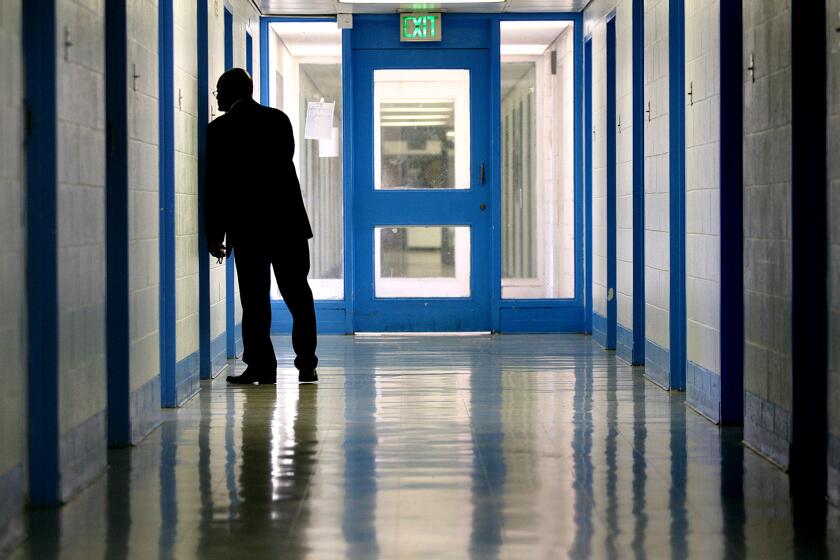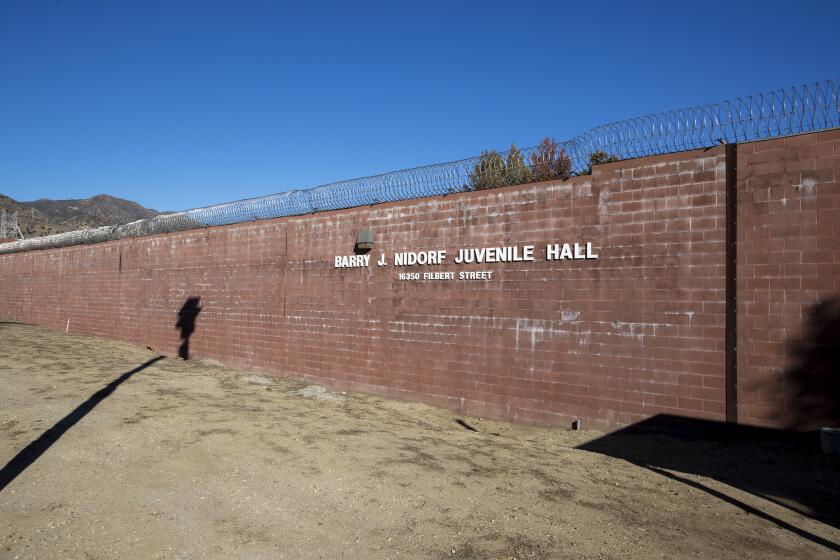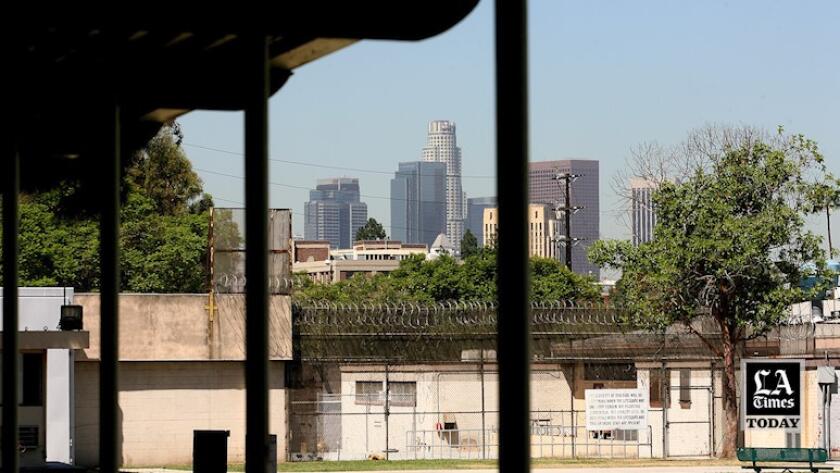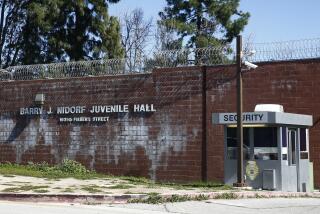California is closing its last youth prisons. Will what replaces them be worse?
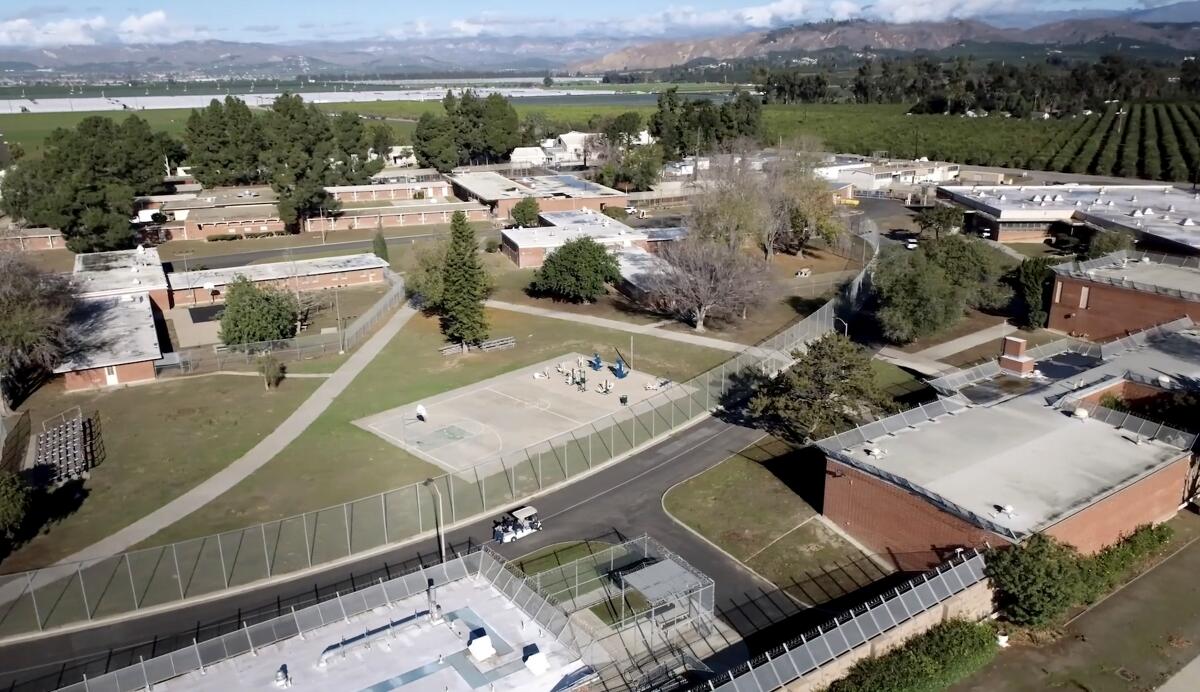
After a two-year wind-down, California is in the final weeks of closing its notoriously grim youth prison system, a landmark moment that arrives as juvenile crime hovers at near-record lows and state leaders call for a shift in focus from punishment to rehabilitation.
Juvenile justice reformers might otherwise be celebrating the June 30 shutdown of the last two youth prisons in the once-sprawling 10,000-inmate system, except for their deep anxiety about what comes next.
The 11 lockups the Division of Juvenile Justice once operated will be replaced by an array of programs devised by probation departments in California’s 58 counties — many of which have little experience with the long-term care of young people convicted of serious crimes.
Youth advocates fought for years to revamp the state’s juvenile justice model, which operated as a sort of halfway point between county juvenile halls and adult state prisons for youths convicted of serious felonies, including murder. They lambasted the state system for fostering a culture of violence, ethnic conflict and gang intimidation. But they now worry the county replacements are no better prepared to provide the kind of education, recreation and support services most conducive to rehabilitation.
Many of the youths being transitioned out of the Division of Juvenile Justice will land in secure youth treatment facilities, units of local juvenile systems that some advocates describe as “concrete jails.” Concerns about the lockups are running especially high in Los Angeles County, where last month an 18-year-old died of an overdose inside a razor-wired treatment facility that sports the nickname “the Compound.”
Both youths and officers have been assaulted inside the unit in recent months, part of a broader pattern of mismanagement by the Los Angeles County Probation Department that led a state oversight board in May to order the closure of two of the county’s juvenile halls.
“Although DJJ’s closure will end this brutal chapter in California’s history, it will not bring an end to the harm and abuse that exists in each of California’s 58 county-level juvenile justice systems,” read a report from the watchdog Center on Juvenile and Criminal Justice. “These systems ... fall far short of the safe, restorative, and caring approach youth deserve.”
Chief probation officers across California have also voiced concerns. Many probation chiefs forcefully opposed the 2020 reform law, backed by Gov. Gavin Newsom, that ordered “realignment” — the transfer of young people convicted of the most severe crimes back to their home counties. Most have since embraced the concept, saying they can make the shift work.
But within the staff ranks, there is dissent and serious concern. Some veteran probation workers charge that, as the justice system leans toward conciliation and compassion, manipulative — and violent — young prisoners are demanding freedoms that they have not demonstrated they can handle. At least a few L.A. County probation officers complain their young charges are coddled, as staff members are being disrespected and attacked.
“We get no support,” read one anonymous comment to the county’s probation oversight commission during a recent meeting. “Juveniles get pizza, cookies, rewards for assaults on staff, etc. It is very sad and disheartening.”
State regulators had given L.A. County multiple opportunities to bring the juvenile facilities in Sylmar and Boyle Heights into compliance.
Newsom had lofty aspirations four years ago when he called for the shutdown of the system of juvenile prisons that opened in 1942. The governor said the demise of the system, once known as the California Youth Authority, signaled “the beginning of the end of juvenile imprisonment as we know it.”
That optimism capped what had been a decades-long decline in California’s juvenile crime rate. Annual arrests for violent crimes involving youths ages 10 to 17 plummeted nearly 82% in the quarter-century ending in 2021.
Experts cite numerous reasons for the decline, including lower child poverty rates, the rise of intervention programs for at-risk youths, and more progressive law enforcement policies that emphasized putting fewer kids behind bars.
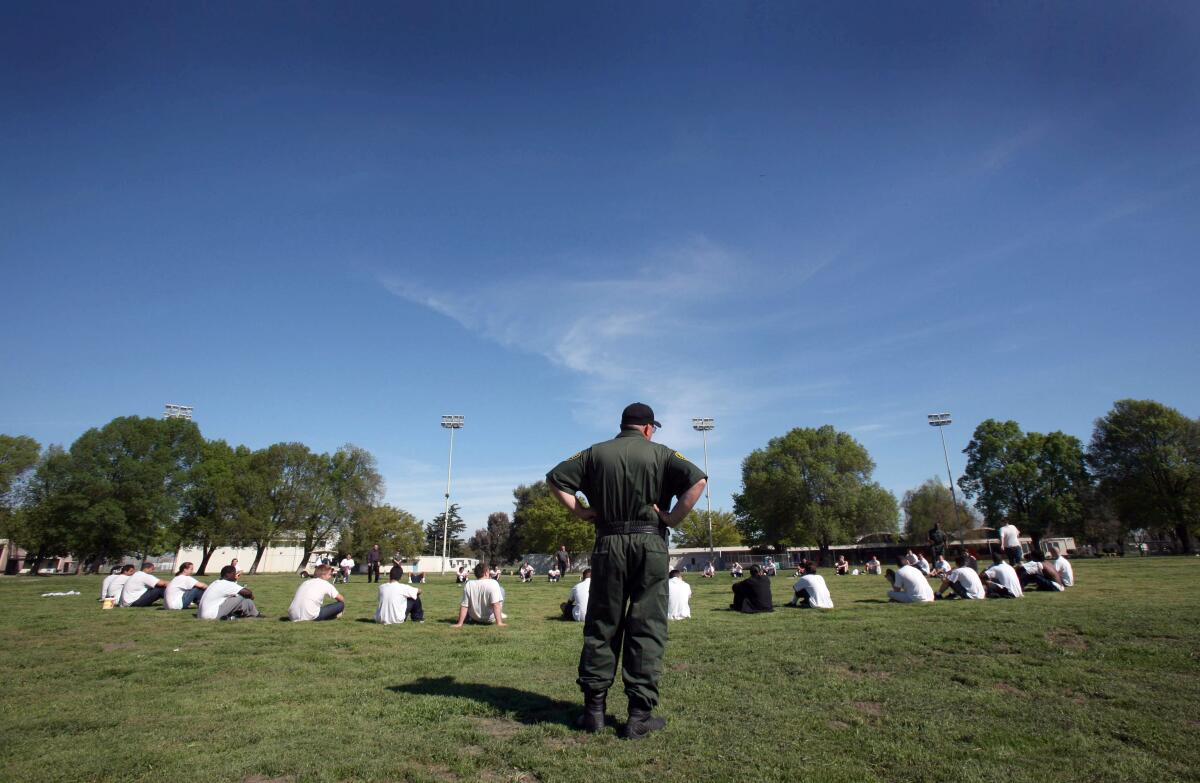
The swift implosion in incarceration numbers drained youth prisons. In 1996, state and county lockups held 20,440 youths. By the end of 2022, the number had fallen to 2,582.
In an effort to cement the trend, the state is shifting responsibility for youth justice from the adult-oriented Department of Corrections and Rehabilitation to a new unit of the Health and Human Services Agency. Counties are getting about $200 million a year in total to assume responsibility for juveniles.
At least 156 young people — nearly all male, like most of the Division of Juvenile Justice’s population — have been returned to their home counties since November, records show. The vast majority have been sent to four counties: Los Angeles, San Diego, Sacramento and San Bernardino. About 175 inmates are left at the division’s two remaining prisons in Ventura and Stockton and its Pine Grove fire camp.
A guiding principle of the decentralization is that detainees do better when they are closer to home, increasing opportunities for visits with family and friends and interactions with community support groups.
The nonprofit Anti-Recidivism Coalition is among the community organizations working with young offenders. It employs “credible messengers,” older people who have built successful lives following incarceration, to help steer young people away from negative behaviors and toward work, education and community service.
In Los Angeles, other advocates are pressing a vision for juvenile justice that would move away from locked wards in favor of homey environments with more academic supports, job opportunities and clear pathways to viable careers.
County probation chiefs say they embrace the concept, but are charged with putting into practice what can feel like antithetical priorities: protecting the community from sometimes aggressive and antisocial young charges who might commit new crimes, while offering young offenders the least restrictive settings possible so they can turn a page in their often bleak personal histories.
San Diego County probation spokesman Chuck Westerheide echoed a theme heard from several probation offices, saying that housing dozens of young offenders closer to home and “connected to their family and local supports is of benefit to the youth and their family, and ultimately to the community.”
Even before the shift to local control, smaller California counties frequently collaborated on juvenile incarceration. Tiny Amador County, for instance, doesn’t operate a juvenile hall and sends its relatively low numbers of young offenders to neighboring counties.
With the Division of Juvenile Justice no longer offering centralized services, smaller counties plan to collaborate more. Sonoma County has offered access to its secure youth treatment facility, which includes a special group for treating sex offenders, to other Northern California jurisdictions — at least in theory. For now, the shutdown of the state youth prisons has diverted so many detainees to the Bay Area that Sonoma is temporarily blocking admissions it didn’t previously agree to.
Brian Richart, chief probation officer in El Dorado County in the central Sierra Nevada, recalls a time early in his career when the message was “to hammer these kids into submission. ... That was the culture. That’s how you were trained.”
Now, his county operates a Juvenile Treatment Center in South Lake Tahoe where the count of young people recently hovered under 15, including several from small counties that don’t operate their own juvenile halls.
One resident, serving time for homicide, returned early from the Division of Juvenile Justice and now tends to an aquarium of exotic fish in the center’s common room. Three full-time psychotherapists provide substance abuse treatment and other counseling. The values of respect and community pervade the facility, Richart said, adding: “We are doing it in a way that shows care and compassion and I am going to even use the word ‘love.’ ”
That’s a far cry from the descriptions from some young offenders inside L.A. County’s secure Compound. More than half a dozen young men who recently spent time there told The Times they experienced little of the “trauma-informed, evidence-based and culturally responsive care” now required by state law, and instead were seeing harsher conditions than inside the Division of Juvenile Justice prisons.
“They can call it a secure youth treatment facility,” said Steven Saavedra, 21, who said he spent time at the Compound this spring. “But it’s not really secure. And there may be some youth, but there’s not any treatment and not even much of a facility.”
Los Angeles County juvenile halls have been cited for unconstitutionally poor conditions for decades. It’s too late to save them.
Tracy Reece, chief probation officer of San Bernardino County, said the county’s new locked facility in Apple Valley, dubbed Restorative Integration for Successful Engagement, has designed promising educational and vocational programs. But a major challenge for the facility, home to 73 young people, is finding enough staff.
With 30% of its available jobs vacant, Reece has had to redeploy probation officers from field positions to jobs inside the Apple Valley lockup to make sure it meets state staffing requirements. Such tactics are generally frowned upon by youth advocates, who say field probation officers, who primarily deal with adults, aren’t trained to address the needs of incarcerated juveniles.
“It’s a good program and we have a great design,” Reece said, “but we need more people to be able to run it the way we want.”
Another concern in the transition is the question of how to ensure meaningful oversight of the youths relocated to county lockups.
Under state regulations, oversight of the new approach falls under a newly created state agency, the Office of Youth and Community Restoration. Its ombudsperson, Efrat Sharony, showed an early willingness to conduct inspections of transfer facilities, visiting L.A. County’s Compound in February.
According to written communications with her supervisors, reviewed by The Times, Sharony reported seeing and smelling “urine coming out from under the cell doors.”
“The young people were shut in their cells, banging on doors and screaming,” according to the observations she relayed.
Some youths told Sharony of being isolated in their cells for more than 18 hours during one lockdown of the larger Nidorf Juvenile Hall.
But it’s unclear whether there were repercussions from her reported observations. And Sharony hasn’t been back inside the Los Angeles lockup or any other facility in the state since February, according to those email exchanges. Her agency’s management ordered her to stand down so they could develop “policies and procedures” for her visits.
“Where is the meaningful oversight?” asked Jasmine Dellafosse, a Stockton-based member of the California Alliance for Youth & Community Justice. “We need to again reinforce the role of the ombudsperson to ensure that reports from young people” can be translated into policy solutions.
Katherine Lucero, a retired judge who now serves as executive director of the Office of Youth and Community Restoration, said in an email that the agency is working to build an ombudsperson division “with the ability to impartially, thoroughly, and systematically investigate ‘harmful conditions or practices, violations of laws and regulations governing facilities, and circumstances presenting an emergency situation.’”
“This is no small undertaking for a state the size of California,” Lucero said, adding that the agency is trying to quickly staff up the division.
She did not directly address reasons for the pause on Sharony’s in-person visits.
Laura Ridolfi, a racial justice strategist at the W. Haywood Burns Institute, is among those concerned that the county-centric model might lead to a reversal of the trend toward finding solutions for young offenders that do not involve locking them up. Ridolfi compiled a survey that shows several county prosecutors may be “net widening” — sentencing more young people to locked facilities as the state prisons are phased out than they had before the shift to local oversight.
San Diego County, for example, has 40 youths in its secure Youth Development Academy and 18 more due to roll in from Division of Juvenile Justice prisons, for a total of 58 youths behind bars. That’s more than the 49 young San Diegans who were locked up in state and county facilities, on average, from 2018 to 2021.
Sacramento County has 66 youths locked up in the division’s prisons and its own secure facility. That’s 21 more than the county average from 2018 to 2021, Ridolfi found. San Bernardino and Ventura are among other counties with more young prisoners today than in recent history.
Several county probation chiefs attributed the higher numbers to new laws making it harder to charge teenagers as adults, channeling them into the juvenile system, and a prohibition on transferring some foster care youths accused of crimes to out-of-state placements.
Marlon Yarber, chief probation officer in Sacramento County, acknowledged the recent bulge in young people held in his county’s alternative to the state youth prisons, the Valley Oak Youth Academy. He said the county “has been of victim of our own success,” becoming “the go-to” option for judges who trust its rehabilitative mission. He said more work will be needed to develop less-restrictive options.
As the counties scramble for answers, the state’s last two youth prisons are preparing to fade into history, ending 81 years in which California operated juvenile prisons.
The system, still known by detainees as “the Y.A.,” goes out under a cloud of anxiety. Employees, who asked not to be named to keep in good standing with administrators, told The Times that a string of drug overdoses have hit the N.A. Chaderjian Youth Correctional Facility in Stockton, the largest remaining prison.
A volunteer at “Chad,” as insiders call it, estimated there have been at least 10 overdoses since the start of the year. One of the staffers recalled twice seeing ambulances transport victims to the hospital. The staffers worry that contraband fentanyl could kill one of the young men before the June 30 closure.
The scope of the drug problem is difficult to assess, because Division of Juvenile Justice officials declined to give a total number of overdose episodes at Chaderjian or the Ventura Youth Correctional Facility. In a statement, the division said it did not have overdose totals and suggested that even a statistical summary would violate “health privacy laws” for reasons it failed to explain.
Spokesman Mike Sicilia said the agency’s director, Heather Bowlds, was not available for an interview.
Dellafosse, of the California Alliance for Youth & Community Justice, said despite her concerns about the way the state shutdown has unfolded, the shift paves the way for long-term improvements.
“Change is hard. At the end of the day, California made one of the best decisions in making the decision to make [this] a public health issue and say we needed to do something different,” she said. “DJJ has not worked. We will only learn from here going forward.”
Watch L.A. Times Today at 7 p.m. on Spectrum News 1 on Channel 1 or live stream on the Spectrum News App. Palos Verdes Peninsula and Orange County viewers can watch on Cox Systems on channel 99.
More to Read
Sign up for Essential California
The most important California stories and recommendations in your inbox every morning.
You may occasionally receive promotional content from the Los Angeles Times.
